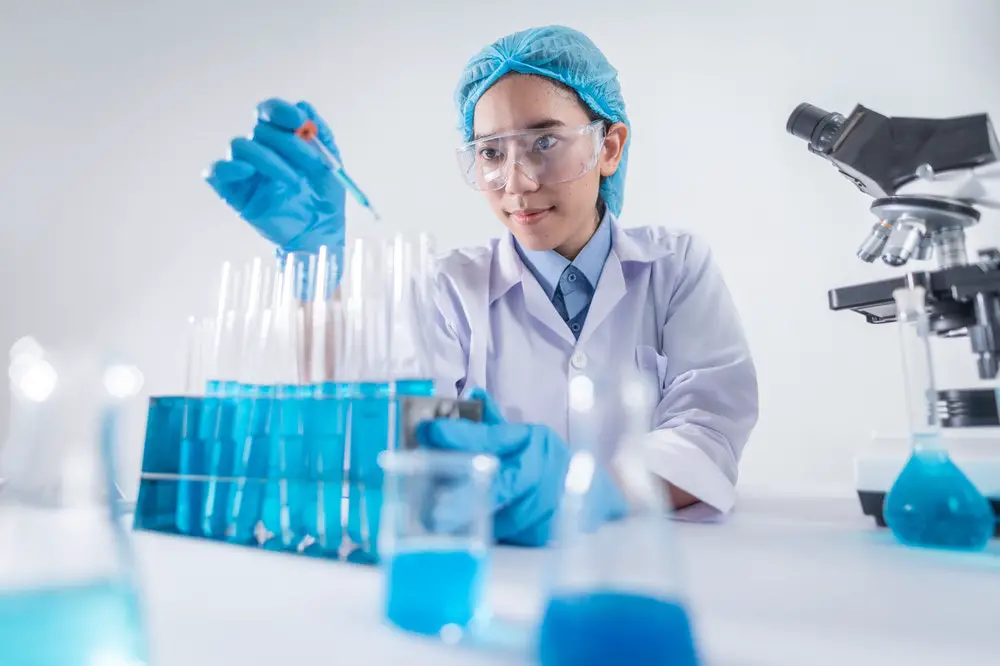Working in laboratories requires many important responsibilities. Whether you are a student, a teacher, or a researcher, it is important to handle chemicals and devices carefully to prevent injuries or accidents. Check out the following 29 trivia lab safety quiz questions and answers to see how well you know about them.
Lab Safety Quiz Questions And Answers

1. What should you do after working with biological specimens, chemicals, and lab substances?
A. Wipe both hands with a towel
B. Wash both hands with water and soap
C. Treat both hands with skin lotion
2. When an acid comes in contact with your skin, you should immediately wash it with what?
A. Water
B. Oil
C. Soap
3. The skull and crossbones symbol is used for which type of hazard in a lab?
A. Biohazardous infection materials
B. Skin irritation or corrosion
C. Acute toxicity
4. Which of the following is a true statement?
A. Avoid wearing contact lenses in the lab, particularly when dealing with chemicals
B. Earphones can be worn as long as you are careful
C. Dangling and dazzling jewellery is acceptable in the lab
5. Which of the following is the best footwear to use in the lab?
A. Closed-toed shoes
B. Open-toed shoes
C. Sandals
6. Which is the right way to look at what is inside a test tube?
A. To look from the bottom
B. To look from an aerial view
C. To look from the side
7. What is used to support and hold a lab crucible?
A. A pipestem triangle
B. A stirring rod
C. An evaporating dish
8. All of the following terms can be used to describe hazardous waste, EXCEPT:
A. Toxicity
B. Corrosivity
C. Enzymatic
9. Where should test tubes be facing when you are heating them?
A. Towards the floor
B. Away from you and other people
C. Towards other people
10. Why we should not add water to a solution containing concentrated acids?
A. Acid would splatter
B. Acid would go bad
C. Acid would change colour
11. What is the proper way to deal with a minor burn on your skin?
A. To apply burn cream
B. To dip your burned area into cold water
C. To wash with water and soap
12. What is the right way to mix water and acid?
A. Slowly add water into acid while stirring the solution
B. Slowly add acid into the water while stirring the solution
C. Add acid into water and shake the solution
13. Where should you never use or dispense flammable materials?
A. A sink
B. An open door
C. A heat source
14. What is the main purpose of wearing goggles and other eye protection devices?
A. To prevent glassware, heat, or chemicals from coming in contact with your eyes
B. To reduce eye strain
C. To improve vision
15. After heating a glass tube, what should you use to pick it up?
A. Pour cold water and use your hands
B. Use tongs
C. Use paper towels
16. What should you do when a chemical comes in contact with your eyes?
A. Put on an eye patch
B. Clean out chemicals with eye drops
C. Wash your eyes thoroughly with water from the fountain
17. What is the right way to smell chemicals inside a tube?
A. Put our nose above the tube
B. Create a fan motion to sweep the fumes to your nose
C. Put your nose to the side of the tube
18. Liquids can be heated safely in which of the following tools?
A. A beaker
B. A wire gauze
C. A funnel
19. What does “MT” mean on a piece of glassware?
A. It is broken
B. It is empty
C. It should be cleaned before each use
20. Which of the following chemicals can be used to neutralise spilt acid on the floor?
A. Potassium chlorate
B. Sodium hydrogen carbonate
C. Nitroparaffin
21. Wearing a fume hood in the lab can help protect you from which of the following factors?
A. Viruses
B. Bacteria
C. Toxic volatiles
22. Which of the following is a common feature of all biosafety cabinets?
A. HEPA filtration
B. Inflow velocity of 100 ft/min
C. Ensure environmental protection
23. How should hazardous materials be stored?
A. On the floor
B. Below eye level
C. In the sink
24. Which of the following substances can be poured safely down the drain?
A. PBS
B. Halogenated hydrocarbons
C. Water-reactive materials
25. Which kind of gloves should you wear in a lab?
A. Nitrile gloves
B. Latex gloves
C. Depending on the handled chemicals
26. Exposure to carcinogens in laboratory may increase the risk of which disease?
A. Kidney diseases
B. Mental diseases
C. Cancer
27. What does the word PPE stand for?
A. Personal Protective Equipment
B. Partial Protection Equipment
C. Private Protective Equipment
28. Which of the following is the most common hazard in general lab settings?
A. Electrocutions
B. Fire
C. Exposure to toxins
29. What are the typical colours of warning signs in the lab?
A. Black and red
B. Black and yellow
C. Grey and orange
We hope these lab safety quiz questions and answers give you some useful tips to reduce the risks of accidents when working in school projects or research. The key is to be careful and stick to the rules. If you want to learn more, check out the following basic chemistry quiz.


Razan sameer allam
No comments
Doha Mohammad mosleh
I had seen the answers
Alessandro Medrano
I got 9 wrong.